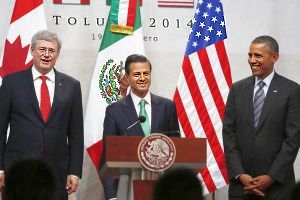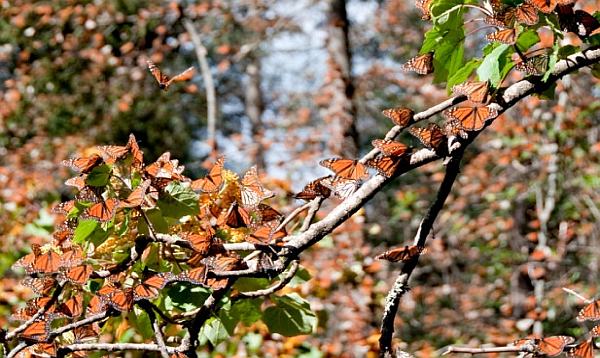Toluca, Mexico - Somewhere in their discussions of trade-facilitating measures, energy integration, and border infrastructures, the three North American leaders found time in their summit last Wednesday for the butterflies.
Flanked by US President Barack Obama and Canadian Prime Minister Steven Harper, Mexican President Enrique Peña Nieto announced at the conclusion of the trilateral meeting here that the countries agreed to set up a task force to devise a plan for saving the continent’s endangered migration of monarch butterflies.
"We have agreed to conserve the monarch butterfly as an emblematic species of North America which unites our three countries," Mr. Peña Nieto said.
 |
| At the summit last week in Toluca, Mexico, the three North American leaders agreed to set up a task force to devise a plan for saving the continent’s endangered migration of monarch butterflies. |
"Today’s pledge by the North American leaders gives us renewed hope that we can save the monarch migration for centuries to come," said Carter Roberts, president and CEO of World Wildlife Fund, in a statement.
It is not just appropriate but necessary, scientists say, that a campaign to preserve the monarchs’ 2,500-mile-long migration from the American Midwest and parts of Canada to wintering sites in Mexico be a trilateral effort. Any successful plan for conserving the monarch migration will have to include habitat-retention plans and a change in agricultural practices in all three countries, they say.
It will also have to cover every phase of the monarch’s annual cycle, which includes migration, hibernation, feeding, and rest.
Yet despite Peña Nieto’s announcement, few details were offered about the planned task force. Moreover, the absence of the new working group from a fact sheet of summit "deliverables" the White House issued, casts doubt on the amount of attention the United States intends to put on the issue.
The White House list did include several steps taken at the summit that, if actually fulfilled, would add new elements to the gradual economic integration of the continent that began 20 years ago with the North American Free Trade Agreement.
Those steps include a plan for a North American "trusted traveler" program to allow vetted citizens to travel more easily among the three countries; an increase in student exchanges to help foster a North American "21st century workforce;" and various border infrastructure and customs initiatives to bring NAFTA up to date.
By leaving the monarchs task force off the "summit deliverables" list, the White House only raised questions about its real interest in the initiative.
Original Story


